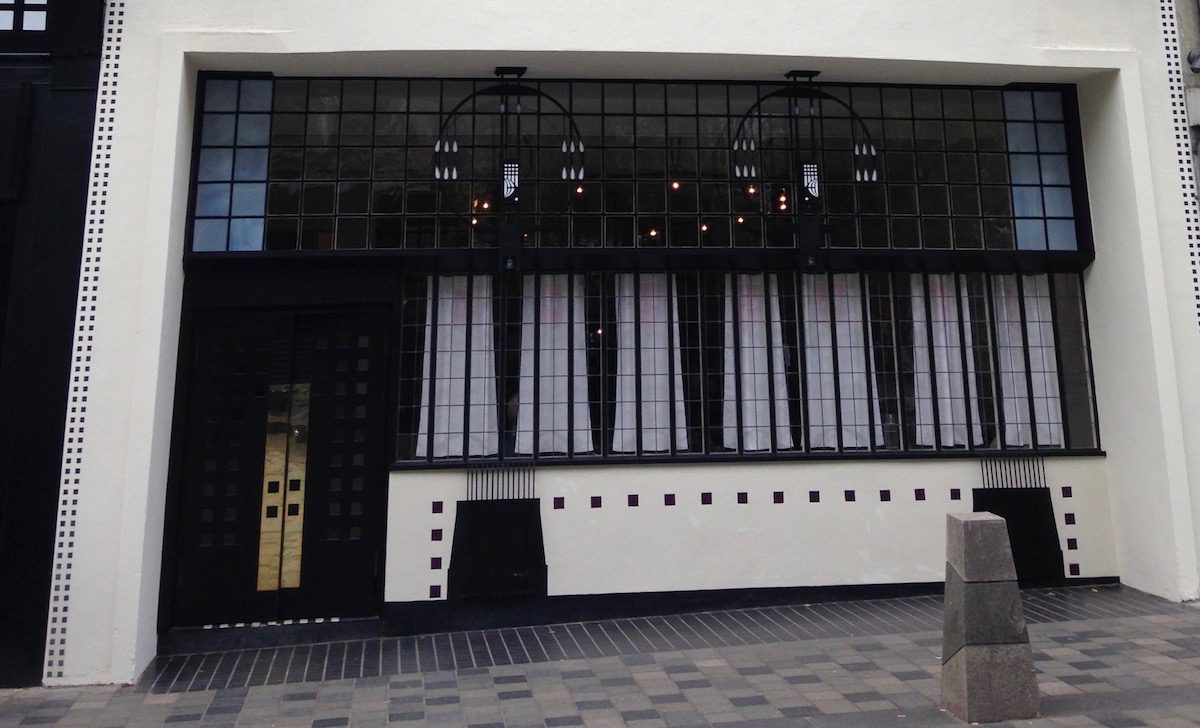Over a hundred years after it first opened, C R Mackintosh’s Willow Tearooms has been revived, restored, remade and reborn. Again in the limelight, it’s a glorious, memorable, unique temple to Glasgow Art Nouveau. In-depth research, superb craftsmanship, immaculate presentation, obsessive attention to detail and over £10m have produced a wonderful, inspirational, revitalised city centre building.
In the wake of the fire tragedy that totally destroyed Glasgow School of Art, this nearby Phoenix is heartily welcome.

Of course, ‘Tearoom’ give the totally wrong impression. Nothing Charles Rennie Mackintosh ever did was less than spectacular. Opened in 1903, the original 3 floors designed entirely by Mackintosh provided Glasgow with a magical, dramatic, revolutionary, outrageous venue. Yet Glaswegians flocked there, soaking up the ultra-modern, oversize mathematically complex chandelier, beaded grey silk and high-backed chairs, some silver with translucent pink squares, his mirrored glass panes leaded with pink and purple, and the fantastic, romantic gesso panel in the silver and purple Room de Luxe.
Not only did he remodel the exterior but he oversaw every interior design element, down to cutlery and waitresses uniform. Commentator Lachlan Goudie points out, “He was obsessive, he was visionary, he was a genius. He created in every building and every interior a complete artistic whole.”
The Willow Tearoom was the last of several that Mackintosh designed for the impressive Miss Cranston. She more or less invented the Glasgow tea room phenomenon, creating a social centre where ladies and businessmen could go for lunch, to read, write letters, play billiards or smoke. They were much more than cafes. These avant-garde spaces were closer to a club – but minus alcohol! Miss Cranston’s first tearoom dates from 1878. Due to the Temperance movement plus the fact that wealthy women had some degree of independence, the tea room concept took off.

At the Willow, the ground floor front, all feminine white and rose, was for Ladies; the dark Luncheon Room behind for men and women. Above, the Tea Gallery is top lit. Next, overlooking Sauchiehall Street with a generous wide curved window is the fabulous, elegant, Room de Luxe. At top a dark panelled Billiard & Smoking Room. Sauchiehall, till recent years, was Glasgow’s grandest, most up-market street.
Over time the Willow was turned into a bridal boutique and jewellery shop, neglected and abused. Efforts at restoration in the 1970s were well-intentioned, but despite its fame, in 2014 the building was due to be sold.
Happily, Glasgow businesswoman Celia Sinclair, who made her money in commercial property, stepped in and bought the building, setting up a trust to restore it. £3.5m from heritage lottery funds helped the restoration.
It has been a long hard task, helped by many lifelong Mackintosh experts like Roger Billcliffe and Pamela Robertson, Mackintosh curator at Glasgow’s Hunterian Art Gallery, perfectly placed to help.
The care that has gone into the renovation or re-creation of the interior with all its fixtures & fittings is remarkable, none more so that the Gesso panel created by Mackintosh’s wife, Margaret Macdonald, which is central to the Room de Luxe. The original too fragile to be used, so Jenny Vaughan created another – a remarkable tour de force.
The theme comes from Sauchiehall – meaning ‘street of the willows’. Here Mackintosh used the leaf & tree, often abstracted in the extreme. As Pevsner commented, “several years before Picasso and Kandinsky had begun their efforts to liberate art from nature.”
Everything including the glass has been hand-made as it was originally, using traditional methods. Working just from old black & white photographs, (there were no drawings!) the panelling, curtains, furniture, carpets were re-created exactly as in 1903. Specialists include glass craftspeople Bryan Hutchison & Ingrid Phillips & cabinet maker Kelvin Murray who had to deliver 400 chairs!
Ironically the private launch of the Willow to celebrate Mackintosh’s 150 Birthday, took place days before the GSA fire. Now the responsibility to keep Mackintosh’s reputation alive and kicking rest on Mackintosh AT THE WILLOW, Glasgow. I am sure it will quickly become a source of international interest & acclaim.

